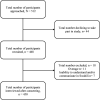Measurement characteristics and correlates of HIV-related stigma among adults living with HIV: a cross-sectional study from coastal Kenya
- PMID: 35193904
- PMCID: PMC8867337
- DOI: 10.1136/bmjopen-2021-050709
Measurement characteristics and correlates of HIV-related stigma among adults living with HIV: a cross-sectional study from coastal Kenya
Abstract
Objective: We studied the psychometric properties of the 12-item short version of the Berger HIV stigma scale and assessed the correlates of HIV-related stigma among adults living with HIV on the Kenyan coast.
Design: Cross-sectional study.
Setting: Comprehensive Care and Research Centre in the Kilifi County Hospital.
Participants: Adults living with HIV on combination antiretroviral therapy were recruited and interviewed between February and April 2018 (n=450).
Main outcome measures: HIV-related stigma.
Results: 450 participants with a median age of 43 years (IQR=36-50) took part in the study. Of these, 356 (79.1%) were female. Scale reliability and validity were high (alpha=0.80, test-retest reliability intraclass correlation coefficient=0.92). Using confirmatory factor analysis, we observed that the 12-item short version of the HIV stigma scale had a good fit for its hypothesised model (Comparative Fit Index=0.966, Tucker Lewis Index=0.955, root mean square error of approximation=0.044). Multigroup confirmatory factor analysis indicated measurement invariance across gender and age groups as ΔCFI was ≤0.01. Multivariate linear regression established that being female (β=2.001, 95% CI: 0.21 to 3.80, p=0.029), HIV status non-disclosure (β=4.237, 95% CI: 1.27 to 7.20, p=0.005) and co-occurrence of depressive and anxiety symptoms (β=6.670, 95% CI: 3.40 to 9.94, p<0.001) were significant predictors of perceived HIV-related stigma and that these variables accounted for 10.2% of the explained variability in HIV-related stigma among adults living with HIV from Kilifi.
Conclusions: Our results indicate that the 12-item short version of the HIV stigma scale is a valid and reliable measure of HIV stigma in Kenya. Furthermore, our study indicates that interventions aimed at reducing stigma need to take into account gender to address the specific needs of women, people who have not disclosed their HIV status, and those exhibiting symptoms of depression and anxiety, thereby improving their quality of life.
Keywords: HIV & AIDS; epidemiology; public health.
© Author(s) (or their employer(s)) 2022. Re-use permitted under CC BY. Published by BMJ.
Conflict of interest statement
Competing interests: None declared.
References
-
- Joint United Nations Programme on HIV/AIDS . Global HIV & AIDS statistics — 2020 fact sheet. Available: https://www.unaids.org/en/resources/fact-sheet [Accessed 22 Feb 2021].
-
- Joint United Nations Programme on HIV/AIDS . UNAIDS data 2020. Switzerland: UNAIDS, 2020. https://www.unaids.org/sites/default/files/media_asset/2020_aids-data-bo...
-
- National AIDS Control Council (NACC) . Kenya AIDS response progress report 2014: progress towards zero. Nairobi, Kenya: National AIDS Control Council of Kenya, 2014. https://www.unaids.org/sites/default/files/country/documents/KEN_narrati...
-
- Stigma GE. Notes on the management of spoiled identity. New York: Simon and Shuster Inc, 1963.
-
- Jones EE, Farina A, Hastorf AH. Social stigma: the psychology of marked relationships. New York: W.H. Freeman, 1984.
Publication types
MeSH terms
Grants and funding
LinkOut - more resources
Full Text Sources
Medical
Miscellaneous

